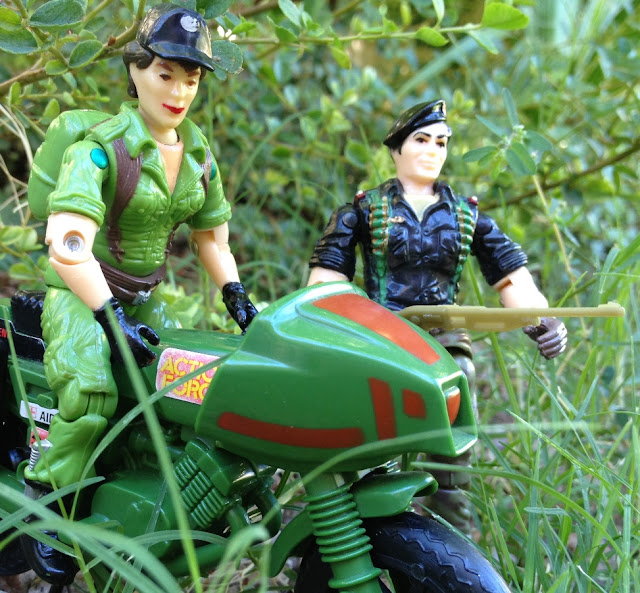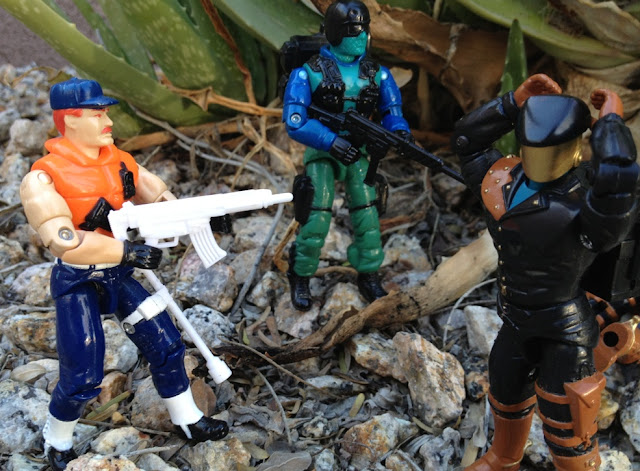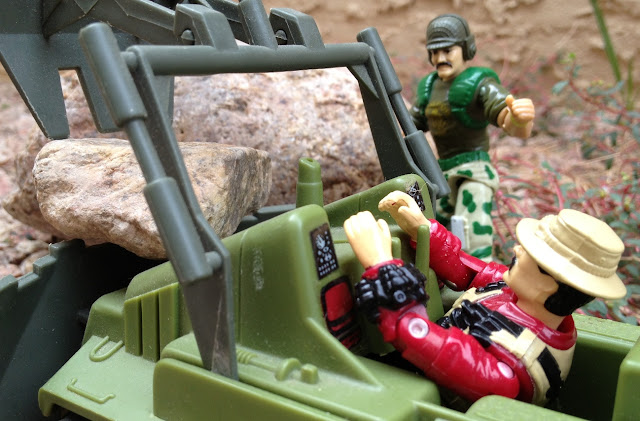As 1985 began, Joe figures showed up in all the various toy and department stores. A friend of mine and I had a competition to see who could find all the figures at retail first. As the cardbacks of the time only named the figure's specialty and not their code name, we were eager to figure out the names of each character. Slowly, we completed the entire set except for three figures. One spring afternoon, I went to Target to find a new stock of Joe figures. Among them were the three figures no one had yet found: Lady Jaye, the Snow Serpent and the Tele-Viper. Unfortunately, just days before, I had begged my parents to buy me Dusty at a local KB toy store. So, they did not let me get a figure and I had no money of my own. So, my younger brothers got a Lady Jaye and Snow Serpent.
However, this Lady Jaye figure didn't look anything like the character in the cartoon or comic. Sure, she had a javelin gun. But, her trademark quiver was missing: replaced with a generic backpack. More noticeable, though, was that the figure featured an awkward baseball cap on Lady Jaye's head. Both her images in the cartoon and comic were sans headgear. The hat simply made no sense. A character that I had looked forward to was now a figure that wasn't great. Her head was large and her feet were bowlegged. Beyond that, she was missing the accessories that had defined her character. As such, I found it hard to use Lady Jaye in her intended purpose.
As such, my vintage Lady Jaye figure got almost no use. It simply wasn't the character the Joe media of the time had made out the character to be. So, the Lady Jaye figure remained basically unused for years and years. Now, as part of the class of 1985, Lady Jaye has some definite display value. Her odd green coloring does work well in some vehicles and she is a staple of my G.I. Joe Headquarters. This Funskool version just gives me another way to incorporate the character into displays. Most of the 1985 figures had some sort of international release. So, having the Funskool version of Lady Jaye helps flesh out my alternate display of early figures that includes Risco, Muralha, Alado and many other Plastirama, Estrela and Funskool takes on classic molds from the line's earliest years.
As a mold, Lady Jaye isn't great. Sure, the body mold is nicely detailed and works just fine. But, the unusually large head, combined with the odd choice of a baseball cap renders the figure rather moot. On top of that, Lady Jaye's feet are somewhat crooked. The toes point more toward each other than they should. If that's not enough, the figure's torso fits somewhat awkwardly into the waist piece. (This is especially pronounced on the 1997 Lady Jaye figure.) For a figure mold from 1985, Lady Jaye was not Hasbro's best effort. Despite those limitations, though, the solid details and colors on the rest of the figure make up for the head's shortcomings. This has kept Lady Jaye a collector favorite despite the problems with the mold.
Lady Jaye's accessories are decent. The javelin gun was a defining character trait. So, seeing it in the figure form was a welcome source of familiarity. Her backpack is not spectacular. It has nice details and is sized for the mold. Not having the trademark javelin quiver is a notch against her overall complement, though. Lady Jaye also includes another accessory: a video camera. There's no real reason for her to have this video equipment. But, it was a neat little side addition to the figure. I used the camera more than I used the figure as it was always helpful to have videotaped evidence of Cobra's nefarious plots. The best part of the camera, though, is how comically dated it now is. In 1985, a small, hand held camera like that was something most people didn't own. Today, I have a camera on my phone that is higher quality and can store longer video than that taped based model. One of the enduring aspects of the Joe line is that it was somewhat forward thinking. While there are some designs that are simply cringe-worthy when viewed through the modern eye, there are many, many more that have held up much better. Lady Jaye as a figure still has some relevance. Her video camera, though, is definitely a relic of her release era.
For many collectors, their opinion of the quality of Funskool figures is shaped by their experiences buying the bulk imports that were produced between 2001 and 2003. During this time, Funskool's quality was spotty at best. It was not uncommon to find sloppy paint applications, frozen joints or figures that fell apart the first time they were moved. In April of 2003, Hasbro tasked Funskool to get their quality act together and the figures produced after that time were much better. However, older Funskool figures were also of great quality. It seems that Funskool's commitment to a great product diminished right as American collectors had the chance to experience their figure offerings. Figures like this Lady Jaye who were produced in the 1990's, are nearly Hasbro level quality. You can see the odd coloring on the figure's face paint. But, the rest of the paint masks are indiscernible from a Hasbro figure. The make up of the plastic is very similar to that used on vintage Hasbro figures and only a slight sense of weakness in the arms really allows a collector to know this isn't a Hasbro release.
The Lady Jaye mold didn't have a great life. This mold was used in the US in 1985. From there, Lady Jaye went off to India. There, Funskool released her for a few years. (Likely between 1993 and 1997.) In that time, there were slight color variants and javelin gun color variants. Funskool also used the Lady Jaye mold for a figure named Canary Ann. This figure was a yellow Lady Jaye with minimal paint applications and a red hat. The figure was sold in a Funskool produced knock off line and is incredibly rare. In 1997, Funskool returned the Lady Jaye mold to Hasbro. (At this point, Hasbro erased the Funskool stamp on the mold and replaced it with a more modern Hasbro used it in 1997 and then again in 1998, only with a new head for the character Volga. Master Collector dusted the mold off in 2003 for the Tiger Force inspired Convention Lady Jaye figure. That is the last time the mold was used. In 2005, though, Hasbro resculpted the Lady Jaye mold. This body is slightly smaller than the original Lady Jaye and was used for Daina in 2005, Lady Jaye in 2006 and the female convention Doc in 2007. As a character, Lady Jaye could stand a few more repaints. However, since the body mold was used for other characters and Lady Jaye has some limitations with the head, collectors probably didn't miss much by having the mold used so few times.
It is likely that Funskool stopped production on Lady Jaye figures in 1997 when they sent the mold back to Hasbro. As such, Lady Jaye was long out of production when collectors began heavily importing Funskool figures in the early 2000's. While not nearly as rare as many of the earliest Funskool figures, Lady Jaye is still not an overly easy find. Carded versions can be rather expensive. But, if you can find loose, mint and complete versions, they will top out around $50. That's pricey for a Joe figure, but is in line with other Funskool figures of similar rarity. For the price, this figure doesn't offer much that isn't available from the American Lady Jaye figure. Sure, the coloring is a bit brighter. But, it's not as stark a difference as you see on many international figures. That allows the modern collector to really pass this release by since it doesn't offer anything remarkably different than the American figure and is much harder to find. As someone who appreciates the subtle differences between international Joe releases, the figure has merit. But, it's probably not enough merit to justify the price it takes to track the figure down.























